Schlumbergera truncata care is easy when you provide the right light, water, and soil conditions. This winter-blooming houseplant thrives indoors, bringing a splash of color even when snow blankets the garden outside.
Also called Thanksgiving cactus, winter cactus, or crab cactus, this succulent plant produces vibrant flowers during the holiday season. Following the practical care steps below helps to avoid common problems such as bud drop and lack of blooms.
This guide offers clear tips to keep your Schlumbergera truncata healthy all year. You’ll learn how to water, fertilize, provide proper light, and maintain humidity for strong stems and reliable flowers – and add a little holiday cheer to your home in the process.
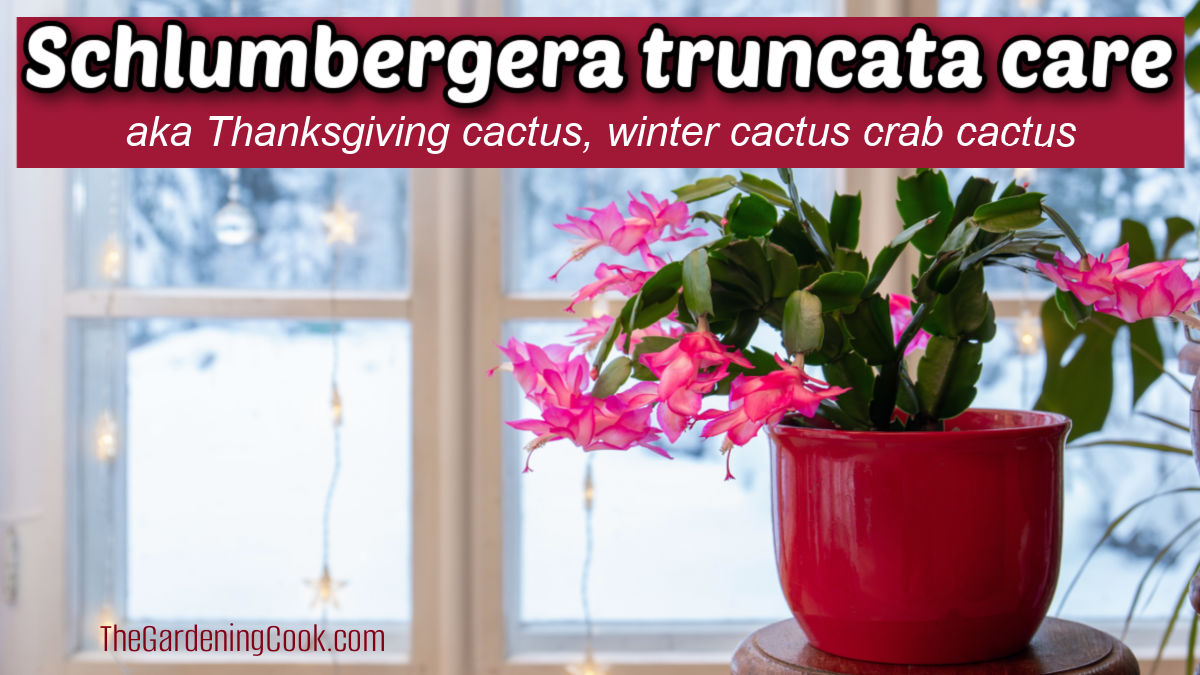
Some of the links below are affiliate links. I earn a small commission, at no additional cost to you, if you purchase through an affiliate link.
Thanksgiving cactus overview
Here is a quick guide to the care of Schlumbergera truncata:
- Common names: Thanksgiving cactus, winter cactus, crab cactus, false Christmas cactus, holiday cactus
- Botanical name: Schlumbergera truncata (S.Truncata)
- Family: Cactaceae
- Plant type: Succulent (ephiphtye)
- Sunlight needs: Bright, indirect light
- Soil requirements: Well-draining, slightly acidic potting mix
- Fertilizing needs: Fertilize during the growing season (spring through early fall)
- Bloom time: Late fall to early winter
- Flower color: Pink, peach, red, or white, depending on type
- Mature size: 12-18 inches (30-45 cm) wide, 6-12 inches (15-30 cm) tall
- Hardiness zones: 10-12
- Toxicity: Mildly toxic to pets if ingested
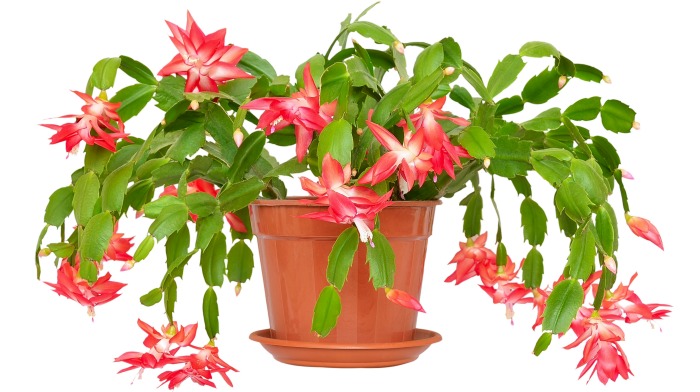
Schlumbergera truncata care tips
Despite its common name, Thanksgiving cactus (Schlumbergera truncata) is not a true cactus. It’s an epiphyte, naturally growing on other plants in its native habitat. It produces beautiful flowers in late fall and winter that last for several weeks.
Read on to learn how to care for a winter cactus to keep it healthy and blooming indoors.
Sunlight needs
Bright, indirect light helps your Thanksgiving cactus to have strong growth and reliable blooms.
- Give the plant bright, indirect sunlight during the fall and winter months.
- An east or north-facing window is ideal.
- Strong sunlight can make the leaves turn brown in the warmer months, so light shade is beneficial.

Soil requirements
Remember their habitat when choosing soil mix for Thanksgiving cactus (S.truncata). The plant normally grows in tree crevices with decaying matter around it, so it likes a slightly acidic soil.
- Use a soil formulated for cacti or succulents.
- Add organic matter, or compost, into the soil.
- A slightly acidic soil with a pH of 5.5 to 6.5 encourages healthy growth.
- Ensure the pot has drainage holes to prevent excess moisture buildup.

Watering requirements
By far, the most important aspect of Thanksgiving cactus care is watering. Don’t let these tropical plants dry out, but be sure that they don’t collect excess water in the root area, either.
- During the flowering period (fall and winter), keep Schlumbergera truncata evenly moist.
- Take the plant to your sink, water it well, and allow the water to drain out of the bottom of the pot.
- Allow the top inch of soil to dry out before watering again.
- When the plant is not flowering, water only enough to keep the leaves from shriveling.
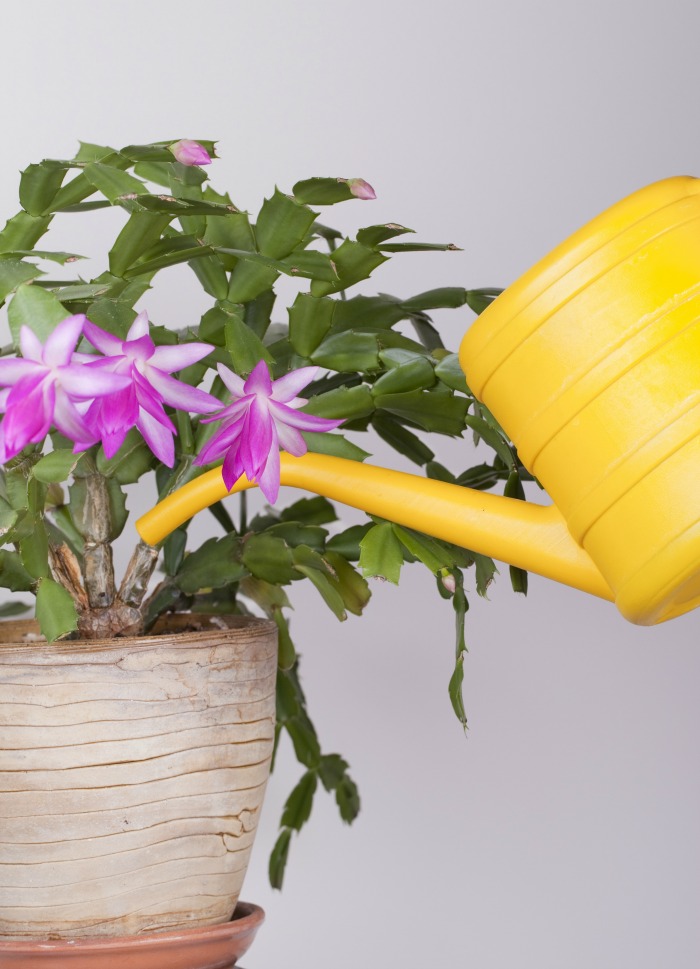
Fertilizing needs
Regularly feeding your winter cactus (S.truncata) supports strong stems and abundant flowers.
- Use a balanced, water-soluble fertilizer every 2-4 weeks during the active growth period (spring through early fall).
- You can also use a balanced, slow-release fertilizer before the growth period starts.
- Reduce the feeding in early fall to mimic the plant’s normal dormancy.
- Avoid over-fertilizing, which can damage the roots and limit the blooms.
Humidity and temperature requirements
Don’t treat your Schlumbergera truncata as a desert cactus! The plant likes moderate to high humidity.
- Room temperatures of 60 to 70 °F (15–21°C) are ideal.
- Cooler nights (around 55–60°F /13–16°C) can promote flower buds.
- Be especially careful of high temperatures when the plant has buds on it. They can cause bud drop.
- Mist occasionally if the indoor air is dry.
- Growing the plant on a tray with water under some pebbles also helps to raise the humidity.
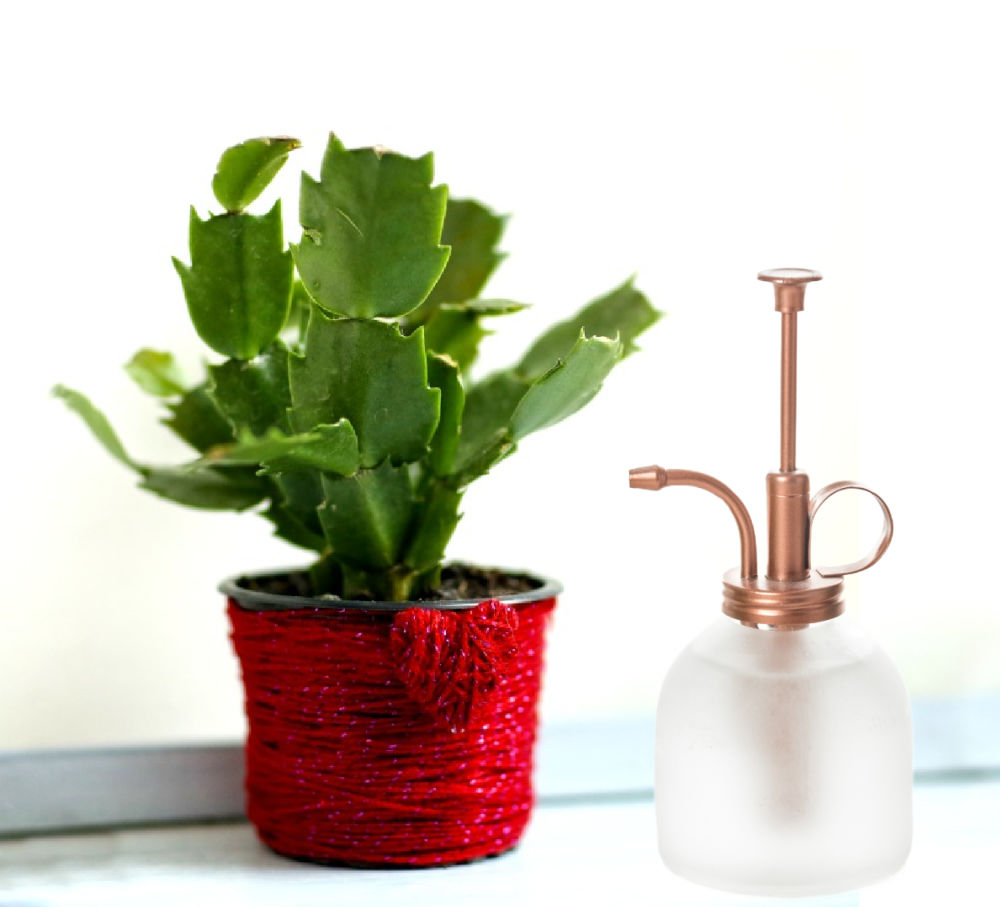
Pests, diseases, and other problems
Schlumbergera truncata is relatively disease-free. Some problems that could occur are these:
- Over-watering can cause fungal diseases, which present as limp leaves that look mushy and easily fall off.
- Leaves turning reddish instead of green can indicate too much sun, too little water, or a lack of phosphorus.
- Mealybugs show up as tiny white insects that look like cotton. Remove these with a Q-tip dipped in rubbing alcohol.
- Spider mites can sometimes be a problem. Treat these with insecticidal soap spray.
- High temperatures, low light, dry conditions, and heat fluctuations can cause buds to drop.
Toxicity to pets and humans
Schlumbergera truncata is considered a low-toxicity plant. See more about the toxicity of other holiday plants here.
- For humans: There are generally no signs of toxicity.
- For dogs: Eating large quantities may cause vomiting and diarrhea, sometimes with traces of blood. Episodes of depression can also occur.
- For cats: In rare cases, ataxia (an unsteady gait) has been reported.
Thanksgiving cactus blooms and foliage
Winter cactus (Schumbergera truncata) has short, tubular flowers with spreading petals. The blooms come in many color varieties, from white, peach, pink, salmon, to orange shades, and those with red flowers.
Its leaves are broad and flat with toothed segments, like crabs, which is the reason for one of its common names – “crab cactus”.
The flower buds grow at the tips of the leaf segments.
Thanksgiving cactus bloom time is late fall through Christmas.
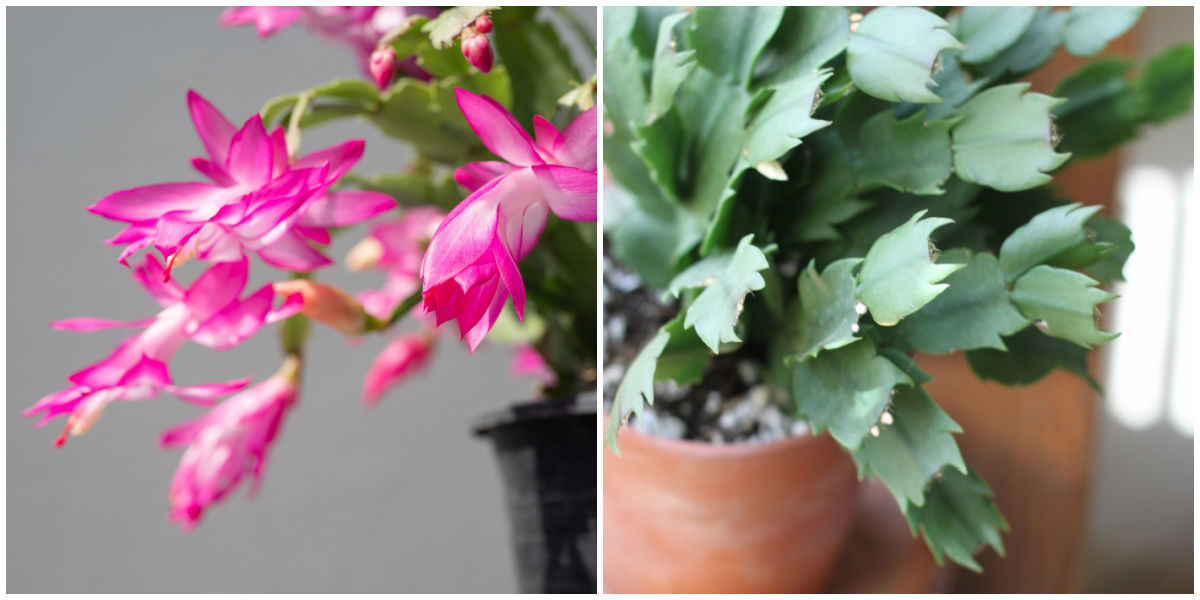
Mature size and growth habit
The mature size of Thanksgiving cactus (S.truncata) can vary greatly depending on the age of the plant.
- Typically, the size is 12-18 inches (30-45 cm) wide and 6-12 inches (15-30 cm) tall.
- Mature plants can grow up to 24 inches (60 cm) tall and wide.
- The growth habit of this holiday cactus is pendulous, making it ideal for hanging baskets.
- Pruning the plant in the spring will encourage it to branch out and become more bushy. This also encourages more blooms.

Cold hardiness
Thanksgiving cactus is a tender perennial.
- It is only cold-hardy outdoors in USDA zones 10 -12.
- If your temperatures are colder than this, you should grow it as an indoor plant.
- It can be moved outside in the summer months. The temperature change from outdoors to indoors, in the fall, will help the plant to rebloom each year.

Advanced care of Schlumbergera truncata
Now that you’ve mastered the basics of Schlumbergera truncata care, there are a few extra steps that can keep your Thanksgiving cactus thriving year after year.
These advanced tips cover getting the plant to rebloom each year and growing more plants from cuttings.
How to make a Thanksgiving cactus bloom
Getting Schlumbergera truncata to flower in subsequent years means tricking it into thinking that it is still in its natural habitat. The plant needs 12 – 14 hours of total darkness, with cool night temperatures of 60 to 65 ° F (15-18°C), for about three to four weeks in order to set buds.
- Winter cactus (S.truncata) requires cool temperatures and shorter daylight hours to bloom. If you don’t get frost, leave the plant outside to experience the weather naturally.
- For colder climates, bring the plant indoors. Keep it in a very cold room with reduced light until buds form.
- An easy way to do this is to put the plant in a cool closet with the closed door each evening and take it out the next morning.
- When buds form, you can return to normal lighting, but try to keep your Thanksgiving cactus cool.
- Pot-bound plants tend to set buds more readily.

Thanksgiving cactus propagation
It is easy to propagate crab cactus (S.truncata) with stem cuttings.
- Cut 3-inch stem sections.
- Dust the ends of the cuttings with a rooting hormone.
- Plant the cuttings in seed-starting soil. Cover with plastic, and roots will grow in about 2 weeks.

Christmas cactus is also propagated in a similar manner.
Difference between Christmas |Thanksgiving | and Easter Cactus
Schlumbergera truncata, also known as Thanksgiving cactus, is one of three holiday cacti that brighten our homes during the cooler months. While Easter cactus and Christmas cactus may look similar, each has its own unique leaf shape and bloom time.
The diagram below shows the differences in leaf shape and flowers for each variety.

All three plants look alike at first glance, but they have subtle differences in leaf shape, flower shape, and bloom time:
- Easter cactus: Rounded leaf segments; blooms in spring around Easter.
- Christmas cactus: Scalloped or teardrop-shaped leaves; blooms in winter around Christmas.
- Thanksgiving cactus: Pointed, claw-shaped leaves; blooms in late fall around Thanksgiving.
Each variety produces flowers from the notches in the stems or at the tips.
Other holiday plants to grow
If you are looking for other holiday plants to enjoy during the cold weather, be sure to also check out these plants:
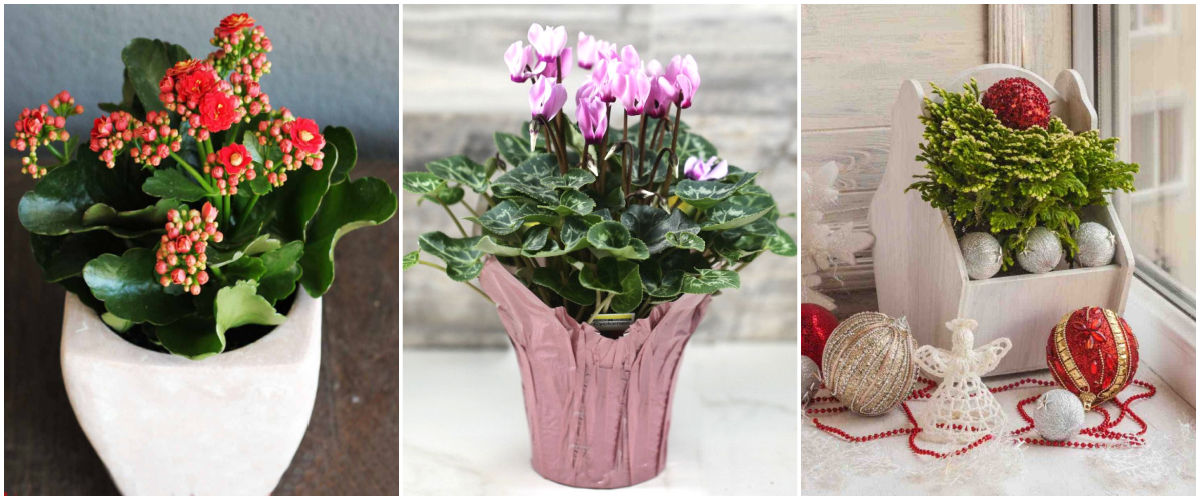
- Florist kalanchoe – This pretty plant is a succulent that will flower for months on end in the winter.
- Florist cyclamen – A less hardy version of the normal cyclamen plant that comes to life in the winter months.
- Frosty fern care – A holiday plant with frosted white tips

Some of the links below are affiliate links. I earn a small commission, at no additional cost to you, if you purchase through an affiliate link.
Where to purchase Thanksgiving cactus
You can find healthy Schlumbergera truncata plants online and in stores from late fall through early winter. Here are a few trusted sources for quality plants:
- You can purchase Schlumbergera truncata on Etsy.
- All three types of holiday cactus are available on Amazon.
- A white Thanksgiving cactus is available at Mountain Crest Gardens.
Share this post about Thanksgiving cactus plant care on X
🎄🌿 Bring the holiday blooms indoors! Learn how to care for Thanksgiving cactus (Schlumbergera truncata) so it thrives and flowers beautifully this season. 🎁🪴👉 Head to The Gardening Cook for tips on growing this holiday cactus.… Share on XPin these winter cactus care tips for Later
Would you like a reminder of this post about how to take care of a Schlumbergera truncata? Just pin this image to one of your Pinterest succulent boards so that you can easily find it later.
You can also watch our video for crab cactus care on YouTube.
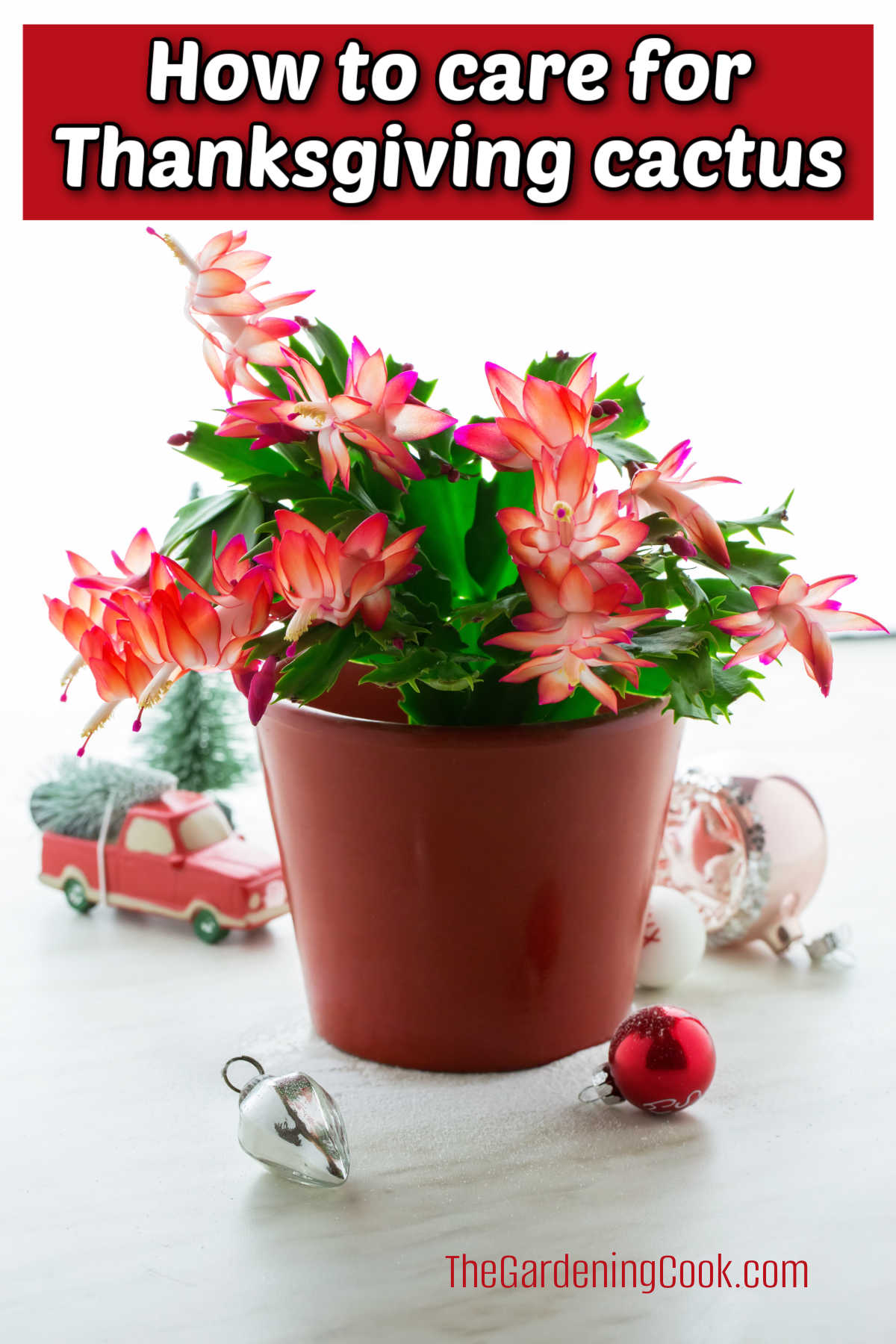
Thanksgiving Cactus Care

Schlumbergera truncata is a holiday cactus that flowers in the fall. It is easy to grow and has long-lasting tubular flowers.
It has many common names: False Christmas cactus, crab cactus, winter cactus, holiday cactus, and Thanksgiving cactus.
Materials
- Schlumbergera truncata plant
- Well-draining succulent/cactus soil
- Balanced liquid fertilizer
Tools
- Watering can
Instructions
- Plant Thanksgiving cactus in well-draining cactus/succulent soil.
- Place the plant outdoors in the shade during the summer months, but bring it indoors if the temperature drops below 50° F (10° C).
- Place the pot in bright light but not direct sunlight.
- Keep evenly moist during the growing season, from spring through late summer.
- Water lightly in the fall until the buds drop.
- Fertilize with a liquid plant food during the active growing time (spring through late summer) every four weeks. Stop fertilizing in the fall.
- The blooming season is from November to March
- Prune well in the spring to encourage a bushier plant.
- Propagate from leaf cuttings in the spring.
- The plant is only cold-hardy in zones 10 and above. In other locations, grow it as a houseplant.
- Watch out for mealy bugs, spider mites, and root rot from too much watering.
Recommended Products
As an Amazon Associate and member of other affiliate programs, I earn from qualifying purchases.
-
 Live Flowering Thanksgiving Cactus in Deco Cover - Assorted Colors (4 Plants Per Pack), Beautiful Holiday Zygocactus
Live Flowering Thanksgiving Cactus in Deco Cover - Assorted Colors (4 Plants Per Pack), Beautiful Holiday Zygocactus -
 3 Orange Cactus Plants Live, Thanksgiving Cactus - Christmas Cactus - Easter Cactus Live Plants, 4-8 Inch Height,
3 Orange Cactus Plants Live, Thanksgiving Cactus - Christmas Cactus - Easter Cactus Live Plants, 4-8 Inch Height, -
 Yellow Peachy Thanksgiving Cactus Live Plant in 2" Pot, Holiday Christmas Cactus Plants Live, Winter Bloom, Indoor Planting
Yellow Peachy Thanksgiving Cactus Live Plant in 2" Pot, Holiday Christmas Cactus Plants Live, Winter Bloom, Indoor Planting
Nancy Campbell
Saturday 12th of April 2025
So glad I found this. Seems I have a Thanksgiving cactus, have had it for a number of years now.It is now April & I am still getting blooms, how lovely!! Think I have 2 plants on one pot because I get fuschia blooms on one side & orange ones on the other side. I was puzzled as to why it blooms a long time off & on, now I see that you think perhaps it is just happy with it's location. OK, I'll take that, love that it is still blooming. Very helpful article. Thank you.
Sandy
Sunday 12th of March 2023
My Thanksgiving cactus came from a leaf on the floor of Home Depot. Took it home and rooted it. That was 10 years ago and doing good.
Joanne
Thursday 28th of July 2022
My Thanksgiving cactus is a little limp purplish on the newest leaves and very shriveled. it's almost 2 yrs old and never had a problem, I checked the roots about 2 months ago and actually let them sit overnight as they seemed a little too damp. the roots were all white, no rotting. I repotted the plant and it seems better but not quite healthy looking as it was. I live in SW florida and its very hot here so I bring it in in the summer months. it's always in filtered light. No direct sun. what can I do to make this healthy again.??
Carol Speake
Saturday 30th of July 2022
It is impossible to diagnose a specific plant problem without seeing the plant in person but it sounds like you did the best thing you could do. Repotting the plant in new soil should help tremendously. Just give it some time and it should improve.
Carey
Friday 25th of March 2022
I was given a Thanksgiving cactus two years ago in late October, it was just starting to bloom. I enjoyed it all through the season. After it bloomed it seemed to like where I had it, in southeast facing window. It grew new leaves and it started to bloom at this year at the end of November. then I noticed it getting blooms again in late January a better batch than the ones in November. It is now March and she is blooming again. Is this normal for the bloom cycle?
Toni
Wednesday 7th of June 2023
@Carol Speake, my cactus bloomed Nov. to the end of Jan. It is now blooming again ( June). I did repot it in between since it seemed to be too large for the pot, so I assumed the repotting caused the present blooms. I also moved it outside fairly recently
Carol Speake
Friday 25th of March 2022
Mine is blooming now too and did the same thing last year. The normal bloom time is around the holidays. I think if it reblooms it just means you have it in ideal conditions and it's a happy plant!
Sandra Ennen
Tuesday 7th of September 2021
Love my Thanksgiving cactus but it needs a bigger pot. How deep/long do the roots get on a mature plant? I like the azalea pots because they are shallower and wider so its more stable and the plant isn't top heavy and likely to tip over so easy.
Carol Speake
Tuesday 7th of September 2021
If you take the root ball out of the pot and look at it, a plant that needs repotting will have a mass of roots around the soil ball. If you don't see lots of roots the plant is still fine in the pot.